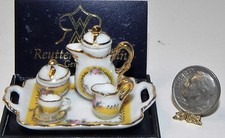I have begun the planting in the back flower border using kits by
Bonnie Lavish and Templewood Miniatures. Most kits of this kind seem to be around £5 each and will make anything from six to eighteen individual flower stems.
I have discovered only this evening that Bonnie Lavish kits are once again being sold via her own website and she also has an FB page,
Bonnie Lavish Miniatures, which is great news for all fans of her very accessible kits.
Templewood Miniatures are based in the UK and have their own range of kits that I have used for the first time in this project. The kits have a very similar technique to the Lavish kits but vary in an interesting way. The leaves are copies of actual leaves so they require no painting or embellishing at all, which is pretty cool. The Templewood kits also provide great value for money as they contain a lot of single flower stems.
Both kits come with full instructions and all the paper and wire parts required to make them up.
I have learnt that there are some basic steps that you cannot ignore when putting together these kits. Number one: when it says wipe glue through the cut, wrapped wire, make sure you do it. Kits that require you to slide on flowers and leaves, need glued wire ends otherwise they will unwrap with handling, something that will annoy you no end!
Number Two: all the kits will benefit from cupping and curling but you must treat the laser sheets with care otherwise you will end up with a lot of split or crushed pieces which are a nightmare to glue onto your wires.
Number Three: make a few kits before getting creative, knowing how to put the kits together easily allows you to work out how each one might be improved upon next time.
I play with the basic kits a lot by painting or shading, or cupping the petals the opposite way directed, or adding different leaves. In reality the kits can provide a great base for you to play with your own ideas.
Number Four: if you are going to paint the leaves or flowers invest in some wax paper as you need to lift the sheets without the problem of them sticking. Wax paper is the best resource I have found to prevent either paint or glue sticking and I would seriously recommend everyone to add it to their craft stash, it is invaluable. After painting you must hang they sheet to dry off, do not let it dry flat, even on the wax paper. You can dab off excess colour onto the wax paper before hanging up to dry.
I have used lots of different means to colour but my main choices would be watercolor and pastel pencils for most detail work. Watered down acrylics are pefect for washes. Again be careful when washing laser sheets as you don't want your leaves/flowers sticking or creasing. Dab off any excess paint if need be and straighten the shapes when wet.
I am going to work on a small portion at a time with a bottom layer of air drying clay to further fix in place any nearby tree. I have then chosen a group of plants and tried to vary both colour and height. The leaves are curled and added to the flower stems and the wires cut to the length required.
From the back: the white stems are made up with a wire dipped in green model railway scenics and then topped with some of the quarter scale dandelion flowers by
Mary Kinloch. The orange flowers are made from a Bonnie Lavish marigold kit, as are the purple dahlias and pink tulips. The white flowers are white anemones by Templewood Miniatures - these are a great buy as each kit makes about 15 stems!
Once I had my group of stems ready I have topped the clay with a tea leaf/PVA mix which allowed me to 'plant' each stem in the 'soil'. You have to move quickly and carefully as the tea leaf mixture will harden off. Good tweezers are definitely a necessity!
Then I moved on to a slightly bigger section which need much taller plants both to hide the LED strip and fill the vertical gap between trees.
Here we have sunflowers, marigolds and roses by Bonnie Lavish. Holly bush by me: it is a wired structure with mini punched holly leaves and caviar bead berries. The tall lilac plants are also made by me. One of the benefits of working with kits is that you get ideas of how plants might be put together using whatever punches you might have at home and how they might work. These lilac plants are a cross between a delphinium and foxglove just using a small leaf and flower punch. Oh and lots of glue and patience!!
The yellow spiked flowers are also made by me. The wires have been dipped in yellow scenic scatter and then I have added some punched leaves from all my previous tree experimentation.
Two very small portions finished so far. I am just beginning to realise how important all the weeks of preparation have been.
I will leave you with my last bit of advice. Once you feel confident with the kits start playing with them and have fun. Use colour, curling, tweaking and any other technique you fancy. Then move onto creating your own plants however you want with paper, beads, scatters and fluff.
It is fun!!










































